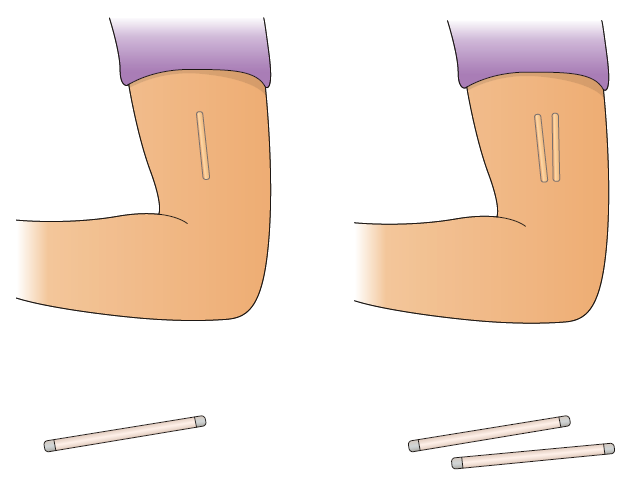Implant (Insertion and Removal)
Pregnancy prevention for 3 to 5 years, remove at any time

Implants are small plastic rods each about the size of matchsticks that release progestine like the natural hormone progesterone in a woman body.
Obtaining consent to insert the implant.
- Offer the client a range of contraceptive methods based on their lifestyle needs and eligibility.
- An implant is ideally inserted in the first five days of the menstrual cycle but can be inserted at any time if you are reasonably certain that the client is not pregnant.
- If insertion is after day 5 of the menstrual cycle and pregnancy has been ruled out, the client should use a backup contraceptive method e.g., condoms for 7 days.
- Implants can be inserted immediately after an abortion (same day of surgical abortion or with the first pill of a medical abortion protocol) but if inserted after day 5 post-abortion, pregnancy must be excluded, and backup contraception should be used for 7 days
- Implants can be inserted immediately after childbirth, even if the client is breastfeeding, but if inserted after day 21 post-partum, pregnancy must be excluded, and backup contraception should be used for 7 days. However, Lev plant (Sino-Implant II) should not be used in breastfeeding clients who are less than 6 weeks post-partum.
- The first time a client has an implant it should ideally be inserted into the non-dominant arm.
- Implant insertion devices are single-use only.

Key points
Once the implant is inserted:
- Ensure the client understands the key details about the implant and its use.
- Ensure the client returns for follow-up in the case of any issues or concerns and for removal and re-insertion
- Offer condoms for STI prevention and back-up and/or dual protection.
- Document insertion and above details in the clinical note
Key aspects of the implant and its use
- The client should be observed for 15-20 minutes after insertion, watching for signs of syncope or bleeding before they are discharged.
- The client should keep the insertion area dry for 4 days. They can remove the bandage or gauze after 2 days and the adhesive bandage after 5 days.
- Mild discomfort and bruising can be expected. However, if the client develops signs of wound infection, hematoma, or other complications they should seek medical advice.
- The client will need to use a backup contraceptive method (such as condoms) for seven days if the implant is inserted after day 5 of the menstrual cycle.
- The client should know how long the implant lasts and that they will no longer be protected against pregnancy after that. They will need to return on the scheduled date for a replacement or for other contraception. Schedule their visit as follows: – After 3 years for Implanon NXT/ Nexplanon and Levoplant (Sino-Implant) – After 5 years for Jadelle.
- A routine follow-up is not required after implant insertion, but the client should seek medical advice if they have intolerable side effects or any concerns. Common problems and their management.
- The client must understand that bleeding changes are common but not harmful. The client may have prolonged irregular bleeding in the first year and then lighter, more regular bleeding, infrequent bleeding, or no bleeding.
- Remind the client that most side effects will resolve within a few months. However, altered bleeding patterns are likely to remain irregular.
- Remind the client that the implant will not protect against STIs and offer condoms for dual protection.
Key risks
- If the client does not understand how the implant works or its limitations, they may request removal and be at risk of unwanted pregnancy.
- If the client does not understand the warning signs of complications, they may delay seeking help.
- If insertion details are not documented in client notes and implant record card, it will be difficult to confirm: – What type of implant was inserted and where – When the implant was inserted and when removal and re-insertion is due.
- Incomplete and poor documentation are legal risks; in the absence of proper documentation there remains no evidence of a properly performed procedure if there is a complaint.
Removing the Implant
Key points
- The implant should be removed if it has expired or the client requests removal.
- Implants are effective for 3 – 5 years, depending on the type of implant, after which they need to be replaced.
- An implant should be removed if the client is found to be pregnant.
- Implant removal is a minor procedure that is similar for all implants.
- If the implant cannot be palpated the client should be referred to an expert implant removal site for an ultrasound scan (USS) or X-ray.
- Never attempt to remove an implant if you cannot palpate it.
- If an implant is replaced, the new implant can be inserted at the original site (if the original implant was correctly placed. If not, the new implant should be placed correctly nearby), or into the other arm.
- If the client decides they want a different contraceptive method after implant removal, they will need counseling on their contraceptive options.
Key risks
- Risk of infection: – The removal site should be kept clean and the removal technique as aseptic as possible.
- Damage to local tissues: – Do not “dig around” looking for implants if they cannot be felt. Refer the client for localization and removal.
- Lack of contraceptive protection: – Once the implant is removed the client returns to their fertile state immediately. The client should have ongoing contraceptive protection if they do not want a pregnancy.
Find your best fit
If you’re unsure what method is best for you, take our online contraception quiz.

If you’re considering an implant, or thinking about using a new method of contraception, it’s a good idea to have a full consultation.
Call us toll-free for a confidential talk on:











